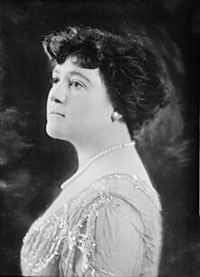
Clara Driscoll was born at Copano Bay in Refugio County in 1881. Her grandfather, an Irish immigrant, had come to Texas and fought at the Battle of San Jacinto in 1836. He later served as a county judge for Refugio County. Her father had built a successful ranch in nearby Nueces County and had expanded into real estate and banking. She attended boarding schools in New York and France and ultimately learned to speak four languages. She settled in San Antonio in 1898 and spoke out against how badly the Alamo had fallen into disrepair.
Once on the outskirts of San Antonio in the quiet countryside, steady growth and expansion of the city soon saw the old mission surrounded by a growing metropolis. At the time of the Texas Revolution, San Antonio was only a small community of perhaps a couple thousand people. By 1910, the population had surged past 96,600 residents, nearly doubling since 1900. The Roman Catholic Church sold the Alamo chapel site to the state in 1883, but other portions remained in private hands. The fiftieth-anniversary commemoration of the battle in 1886, however, was almost ignored by residents. As a result, the Daughters of the Republic of Texas, an organization made up of descendants of veterans of the Texas Revolution, was founded in 1892 with the aim of preserving the Alamo.
By 1903, Adina de Zavala, a writer and granddaughter of Lorenzo de Zavala, the first vice-president of the Republic of Texas, convinced Driscoll to aid in the cause. The owners of the long barracks, once a convent, hoped to sell the site to developers and allowed the crumbling structure to be overrun with billboards. The DRT attempted to purchase the building, but the asking price was $75,000 (more than $2 million in 2018 dollars). Determined not to let the Alamo fall to developers, Driscoll put up most of the asking price herself in January 1905. The state legislature, impressed with their efforts, compensated the DRT and enacted legislation to put the site into their care.
However, an argument erupted between Zavala and Driscoll over the fate of the Long Barracks. Driscoll offered to tear down the dilapidated building as part of the DRT’s reconstruction efforts, but Zavala argued that it was an original part of the building and a vital part of Alamo history. Gov. Oscar B. Colquitt sided with Zavala and asked it be restored. The case went to court, with the judge stating the DRT had ownership.
Instead of being completely demolished, the second floor was removed instead and rebuilt the walls of the first floor between 1913 and 1916. By 1921, the DRT added a concrete roof to the chapel to replace the old, wooden roof and installed electrical lighting. In 1931, Driscoll put up another $70,000 of her own money (more than $1.1 million in 2018 dollars) to help the state legislature buy more of the land surrounding the Alamo site.
In the meantime, Driscoll also embarked on a modest writing career, penning the novels The Girl of La Gloria in 1905 and In the Shadow of the Alamo in 1906. She married Hal Sevier in 1906, who founded what became the Austin American-Statesman and later became the U. S. Ambassador to Chile.
In 1936, Driscoll was named vice-chair of the Texas Centennial Exposition executive board, overseeing the commemorations of the one hundredth anniversary of Texas independence. As president of the Daughters of the Republic of Texas, she made sure the Alamo received special attention for its role in the events of 1836. In the years following, the Alamo story continued to spread, and the site became the most popular tourist spot in San Antonio. It became a National Historic Landmark in 1960.
After her divorce in 1937, she spent most of her last years in Corpus Christi, managing her family’s real estate and ranching interests. She had the Hotel Robert Driscoll built in 1942, named after her late brother. She continued to giver generously to causes across the state. Driscoll lived in a suite in the hotel until her death in 1945 at age 64. Upon her death, she was given the rare honor of having her body lie in state at the Alamo chapel, the shrine she worked so tirelessly to preserve.
Even in death, she was able to open another chapter in Texas History. Driscoll left the bulk of her family’s fortune to help the children of others. She directed funds from her estate to establish a children’s hospital in Corpus Christi. Driscoll Children’s Hospital opened in Corpus Christi in 1953. To date, it is the only children’s hospital in South Texas and has since expanded to include clinics across the Rio Grande Valley.

